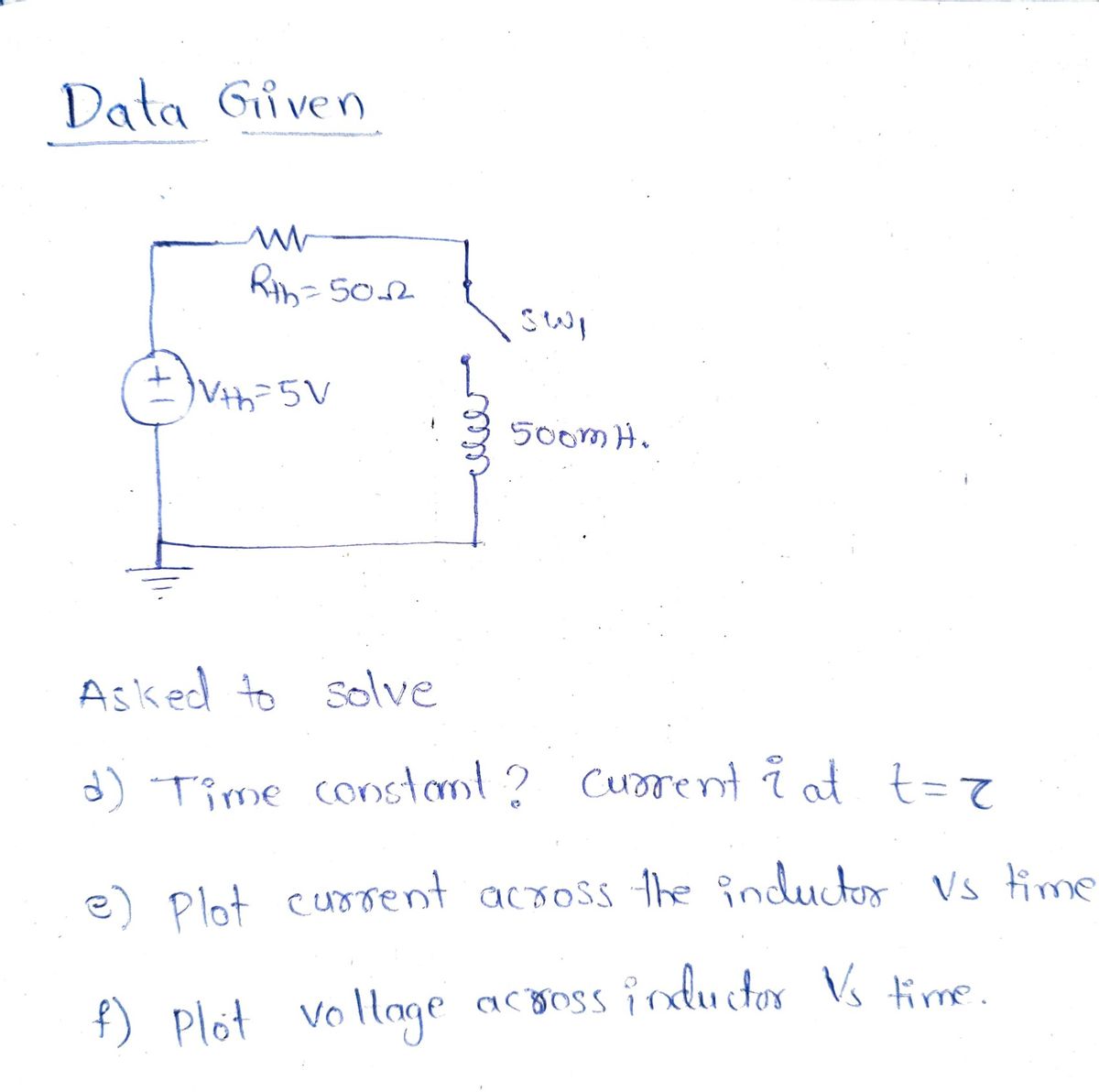Consider the circuit shown below left. ww 100 Ω 5 V SW1 500 mH ww 100 02 ww Rth Vth SW1 a ell 500 mH a. The switch and inductor can viewed as being attached to Thevenin equivalent circuit shown (above right). Show that Vth=2.5V and Rth=50 2. b. Derive the governing equation for the inductor current using KVL and state the initial condition. c. Solve the governing equation to determine the current through the inductor with time if the switch is closed at t=0. d. What is the time constant t for the circuit? What is the current at t=t? e. Plot the current across the inductor vs. time. f. Plot the voltage across the inductor vs. time.
Consider the circuit shown below left. ww 100 Ω 5 V SW1 500 mH ww 100 02 ww Rth Vth SW1 a ell 500 mH a. The switch and inductor can viewed as being attached to Thevenin equivalent circuit shown (above right). Show that Vth=2.5V and Rth=50 2. b. Derive the governing equation for the inductor current using KVL and state the initial condition. c. Solve the governing equation to determine the current through the inductor with time if the switch is closed at t=0. d. What is the time constant t for the circuit? What is the current at t=t? e. Plot the current across the inductor vs. time. f. Plot the voltage across the inductor vs. time.
Introductory Circuit Analysis (13th Edition)
13th Edition
ISBN:9780133923605
Author:Robert L. Boylestad
Publisher:Robert L. Boylestad
Chapter1: Introduction
Section: Chapter Questions
Problem 1P: Visit your local library (at school or home) and describe the extent to which it provides literature...
Related questions
Question
Please answer, d-f plz

Transcribed Image Text:## Circuit Analysis Exercise
### Circuit Diagram
- **Left Circuit:**
- A 5 V battery is connected in series with a switch (SW1), a 100 Ω resistor, and a 500 mH inductor.
- **Right Circuit (Thevenin Equivalent):**
- The circuit components are replaced by an ideal voltage source (Vth) in series with a resistor (Rth) and a 500 mH inductor.
### Tasks
#### a. Thevenin Equivalent
- Demonstrate that the Thevenin equivalent voltage (Vth) is 2.5 V and the Thevenin equivalent resistance (Rth) is 50 Ω.
#### b. Govern Equation
- Derive the equation governing the inductor current using Kirchhoff’s Voltage Law (KVL) and specify the initial condition.
#### c. Solution for Inductor Current
- Solve the governing equation to find the inductor current over time, given that the switch is closed at t=0.
#### d. Time Constant and Current
- Calculate the time constant (τ) for the circuit.
- Determine the current at t=τ.
#### e. Current vs. Time Plot
- Create a plot illustrating the current across the inductor over time.
#### f. Voltage vs. Time Plot
- Create a plot showing the voltage across the inductor over time.
### Additional Notes
- The analysis uses fundamental principles of electrical engineering, emphasizing the application of Thevenin’s Theorem and KVL.
- The time constant is a critical parameter indicating how quickly the current reaches a steady state.
- The plots required in tasks e and f provide a visual representation of how current and voltage evolve, offering deeper insight into inductor behavior in circuits.
Expert Solution
Step 1

Step by step
Solved in 4 steps with 4 images

Knowledge Booster
Learn more about
Need a deep-dive on the concept behind this application? Look no further. Learn more about this topic, electrical-engineering and related others by exploring similar questions and additional content below.Recommended textbooks for you

Introductory Circuit Analysis (13th Edition)
Electrical Engineering
ISBN:
9780133923605
Author:
Robert L. Boylestad
Publisher:
PEARSON

Delmar's Standard Textbook Of Electricity
Electrical Engineering
ISBN:
9781337900348
Author:
Stephen L. Herman
Publisher:
Cengage Learning

Programmable Logic Controllers
Electrical Engineering
ISBN:
9780073373843
Author:
Frank D. Petruzella
Publisher:
McGraw-Hill Education

Introductory Circuit Analysis (13th Edition)
Electrical Engineering
ISBN:
9780133923605
Author:
Robert L. Boylestad
Publisher:
PEARSON

Delmar's Standard Textbook Of Electricity
Electrical Engineering
ISBN:
9781337900348
Author:
Stephen L. Herman
Publisher:
Cengage Learning

Programmable Logic Controllers
Electrical Engineering
ISBN:
9780073373843
Author:
Frank D. Petruzella
Publisher:
McGraw-Hill Education

Fundamentals of Electric Circuits
Electrical Engineering
ISBN:
9780078028229
Author:
Charles K Alexander, Matthew Sadiku
Publisher:
McGraw-Hill Education

Electric Circuits. (11th Edition)
Electrical Engineering
ISBN:
9780134746968
Author:
James W. Nilsson, Susan Riedel
Publisher:
PEARSON

Engineering Electromagnetics
Electrical Engineering
ISBN:
9780078028151
Author:
Hayt, William H. (william Hart), Jr, BUCK, John A.
Publisher:
Mcgraw-hill Education,